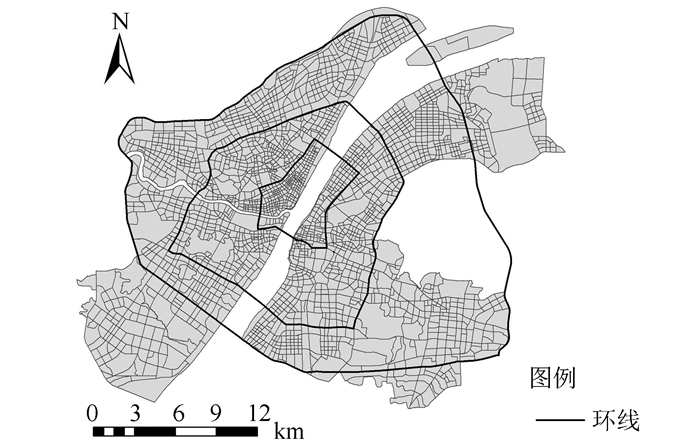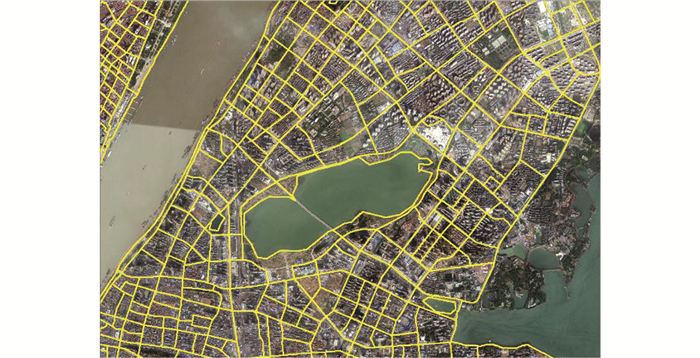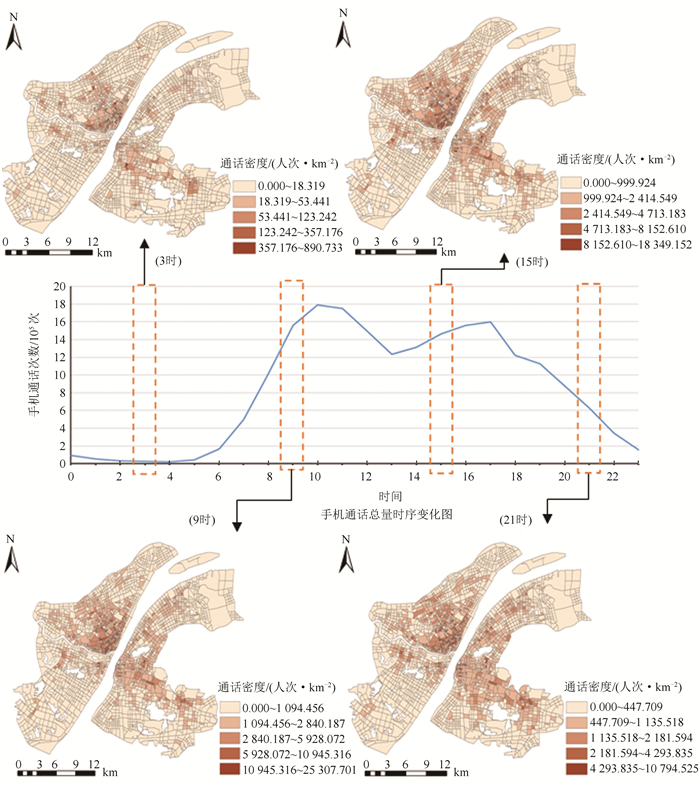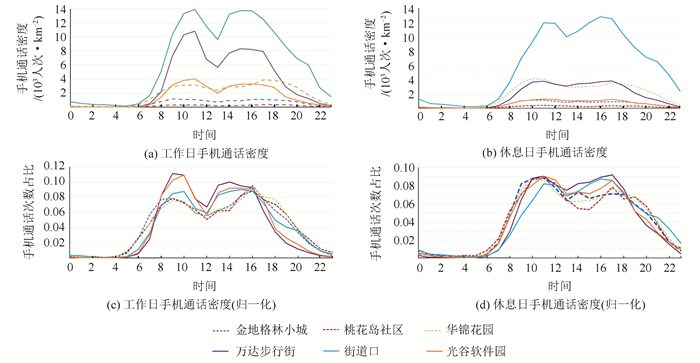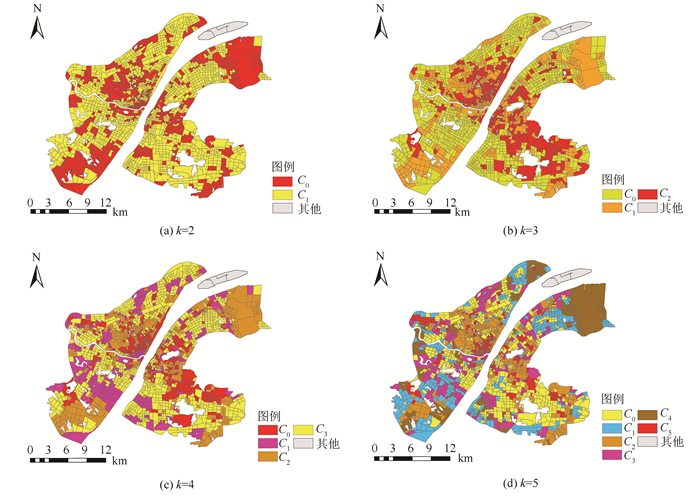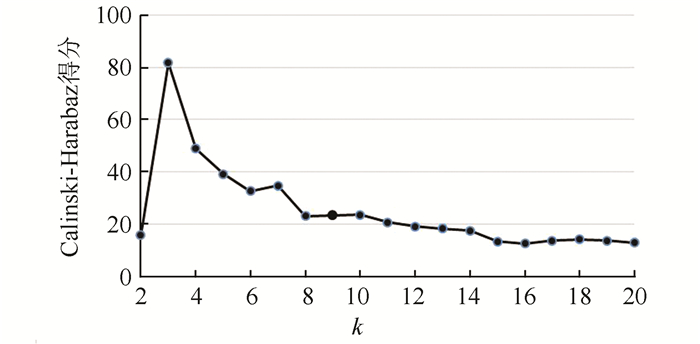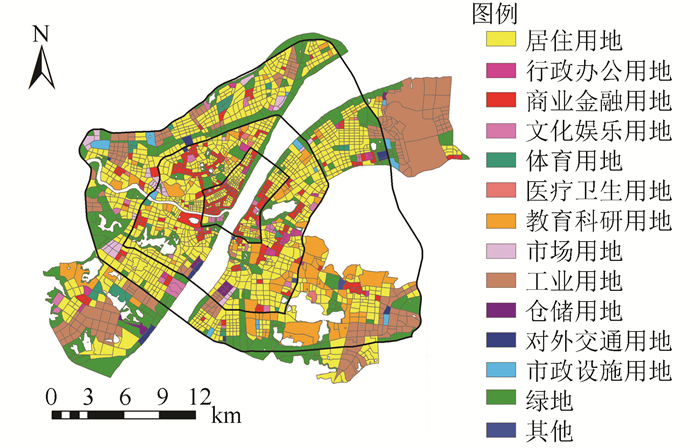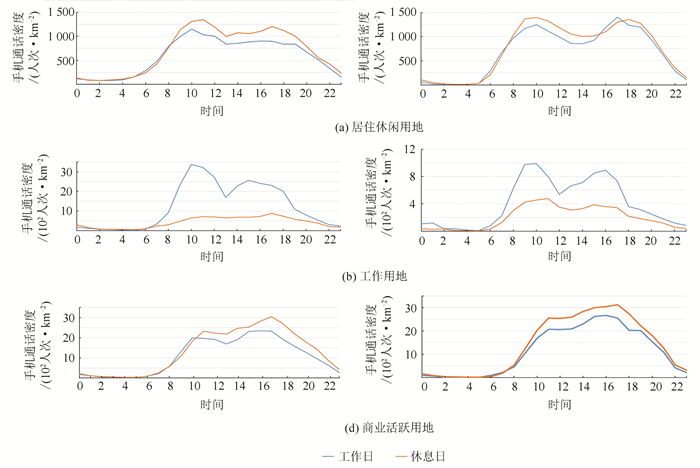-
摘要: 城市土地利用是人的活动与城市物质空间交互所表现出的综合结果,因此人的活动与城市土地利用功能密切相关;具有不同时间段人的活动的空间聚集与分散规律的区域,其所属的社会功能属性亦不相同。随着大数据时代的到来,以居民手机数据为代表的基于位置的服务数据(local basic service,LBS)大量出现,使得实现时空全覆盖和精细化地监测城市人的活动成为可能。因此,利用手机数据的优势,能够实现从人的角度来区分识别城市用地功能类型。利用手机通话详单数据(call detail records,CDRs)提取面向地块尺度的居民通话聚合时序特征,提出了一种城市土地利用类型谱聚类识别方法。以武汉市为例进行实验分析,结果表明,该方法识别城市土地利用的平均精度为54.6%,为探知城市土地利用空间分布提供了一个有效的方法。Abstract: The spatial and temporal characteristics of human activities are closely related to the function of urban land use, so the social-economic function of the urban parcel can be inferred by the spatial aggregation and dispersion of human activities. Cell phone is the most popular communication terminal equipment and the distribution of cell phone users is able to reflect the distribution of population accurately. Local basic service (LBS), which is acquired from residents' cell mobile data, is constantly emerging and make it possible to achieve spatial and temporal coverage and meticulous monitoring of urban people's activities. Therefore, the mobility data of cell phone users have the potential to infer the land use function of the urban parcels. In this paper, the call detail records(CDRs), will be adopted to cluster the urban land use patterns. Firstly, the clustering characteristics of call aggregation for local scale are extracted, then a spectral clustering recognition method for urban land use is proposed. Taking Wuhan as an experimental area, the average accuracy of the method for urban land use identification is 54.6%, and the results show that this method has advantages in urban land use identification.
-
-
表 1 手机基站数据记录信息表
Table 1 Records of Mobile Base Stations
用户身份标识号 记录时间 区域码(LAC) 基站编码(CID) 00000001 20**-**-**T15:39:14-000000 712D 0E1E 00000002 20**-**-**T15:22:41-000000 708B 63D1 00000004 20**-**-**T16:46:44-000000 703D 4598 表 2 基站信息表
Table 2 Base Station Information
基站识别号 经度/(°) 纬度/(°) 286****852 114.404 9 30.406 45 291****537 114.163 0 30.476 21 287****065 114.421 8 30.422 47 表 3 聚类结果与总体规划土地利用对比表
Table 3 Comparison of Clustering Results and Master Plan Land Use
用地类型 C0 C1 C2 精度 居住用地 649 233 408 0.503 行政办公用地 4 22 14 0.550 商业金融用地 45 122 131 0.439 文化娱乐用地 12 11 11 0.353 体育用地 15 0 8 0.652 医疗卫生用地 3 5 4 0.417 教育科研用地 22 18 67 0.626 市场用地 8 18 10 0.500 工业用地 86 112 22 0.509 仓储用地 8 2 0 0.800 对外交通用地 5 4 2 0.455 市政设施用地 11 0 2 0.846 绿地 150 89 57 0.507 特殊用地 0 1 1 -
[1] Tao P, Sobolevsky S, Ratti C, et al. A New Insight into Land Use Classification Based on Aggregated Mobile Phone Data[J]. International Journal of Geographical Information Science, 2014, 28(9):1988-2007 doi: 10.1080/13658816.2014.913794
[2] Foody G M. Fully Fuzzy Supervised Classification of Land Cover from Remotely Sensed Imagery with an Artificial Neural Network[J]. Neural Computing & Applications, 1997, 5(4):238-247 doi: 10.1007/BF01424229
[3] Zhong Y, Zhu Q, Zhang L. Scene Classification Based on the Multifeature Fusion Probabilistic Topic Model for High Spatial Resolution Remote Sensing Imagery[J]. IEEE Transactions on Geoscience & Remote Sensing, 2015, 53(11):6207-6222 http://ieeexplore.ieee.org/document/7119589/
[4] Zhong Y, Zhao B, Zhang L. Multiagent Object-Based Classifier for High Spatial Resolution Imagery[J]. IEEE Transactions on Geoscience & Remote Sensing, 2013, 52(2):841-857 http://ieeexplore.ieee.org/document/6494281/
[5] Liu Y, Liu X, Gao S, et al. Social Sensing:A New Approach to Understanding Our Socioeconomic Environments[J].Annals of the Association of Ame-rican Geographers, 2015, 105(3):512-530 doi: 10.1080/00045608.2015.1018773
[6] 龙瀛, 张宇, 崔承印.利用公交刷卡数据分析北京职住关系和通勤出行[J].地理学报, 2012, 67(10):1339-1352 doi: 10.11821/xb201210005 Long Ying, Zhang Yu, Cui Chengyin. Identifying Commuting Pattern of Beijing Using Bus Smart Card Data[J]. Acta Geographica Sinica, 2012, 67(10):1339-1352 doi: 10.11821/xb201210005
[7] Liu Y, Wang F, Xiao Y, et al. Urban Land Uses and Traffic Source-Sink Areas:Evidence from GPS-Enabled Taxi Data in Shanghai[J]. Landscape & Urban Planning, 2012, 106(1):73-87 http://www.sciencedirect.com/science/article/pii/S0169204612000631
[8] Yao Y, Li X, Liu X, et al. Sensing Spatial Distribution of Urban Land Use by Integrating Points-of-Interest and Google Word2Vec Model[J]. International Journal of Geographical Information Systems, 2016, 31(4):825-848 doi: 10.1080/13658816.2016.1244608
[9] Steenbruggen J, Tranos E, Nijkamp P. Data from Mobile Phone Operators:A Tool for Smarter Cities?[J]. Telecommunications Policy, 2015, 39(3):335-346 http://www.sciencedirect.com/science/article/pii/S0308596114000603
[10] 徐仲之, 曲迎春, 孙黎, 等.基于手机数据的城市人口分布感知[J].电子科技大学学报, 2017, 46(1):126-132 doi: 10.3969/j.issn.1001-0548.2017.01.018 Xu Zhongzhi, Qu Yingchun, Sun Li, et al. Urban Population Sensing via Mobile Phone Data[J]. Journal of University of Electronic Science and Technology of China, 2017, 46(1):126-132 doi: 10.3969/j.issn.1001-0548.2017.01.018
[11] 钮心毅, 丁亮, 宋小冬, 等.基于手机数据识别上海中心城的城市空间结构[J].城市规划学刊, 2014(6):61-67 doi: 10.3969/j.issn.1000-3363.2014.06.009 Niu Xinyi, Ding Liang, Song Xiaodong, et al.Understanding Urban Spatial Structure of Shanghai Central City Based on Mobile Phone Data[J]. Urban Planning Forum, 2014(6):61-67 doi: 10.3969/j.issn.1000-3363.2014.06.009
[12] Tu W, Cao J, Yue Y, et al. Coupling Mobile Phone and Social Media Data:A New Approach to Understanding Urban Functions and Diurnal Patterns[J]. International Journal of Geographical Information Science, 2017, 31(12):2331-2358 doi: 10.1080/13658816.2017.1356464
[13] Toole J L, Ulm M, Bauer D. Inferring Land Use from Mobile Phone Activity[C]. The ACM SIGKDD International Workshop on Urban Computing, Beijing, China, 2012
[14] González M C, Hidalgo C A, Barabási A L. Understanding Individual Human Mobility Patterns[J]. Nature, 2008, 453(7196):779-782 doi: 10.1038/nature06958
[15] Kuusik A, Ahas R, Tiru M. Analysing Repeat Visitation on Country Level with Passive Mobile Positioning Method:An Estonian Case Study[J]. Discussions on Estonian Economic Policy, 2009, 17:140-155 http://www.researchgate.net/publication/307685047_Analysing_Repeat_Visitation_on_Country_Level_with_Passive_Mobile_Positioning_Method_an_Estonian_Case_Study
[16] Song C, Qu Z, Blumm N, et al. Limits of Predictability in Human Mobility[J]. Science, 2010, 327(5968):1018-1021 doi: 10.1126/science.1177170
[17] Traag V A, Browet A, Calabrese F, et al. Social Event Detection in Massive Mobile Phone Data Using Probabilistic Location Inference[C]. The Third International Conference on Privacy, Security, Risk and Trust, Boston, USA, 2011
[18] Luxburg U. A Tutorial on Spectral Clustering[J]. Statistics & Computing, 2007, 17(4):395-416 doi: 10.1007-s11222-007-9033-z/
[19] Shi J, Malik J. Normalized Cuts and Image Segmentation[J].IEEE Transactions on Pattern Analysis & Machine Intelligence, 2000, 22(8):888-905 http://d.old.wanfangdata.com.cn/Periodical/jsjyyyj200702054
[20] Caliński T, Harabasz J. A Dendrite Method for Cluster Analysis[J]. Communications in Statistics, 1974, 3(1):1-27 doi: 10.1080-03610927408827101/
[21] Calabrese F, Ferrari L, Blondel V D. Urban Sen-sing Using Mobile Phone Network Data:A Survey of Research[J]. ACM Computing Surveys (CSUR), 2015, 47(2):1-25 https://www.sciencedirect.com/science/article/pii/S1566253517303421
[22] Louail T, Lenormand M, Cantu Ros O G, et al. From Mobile Phone Data to the Spatial Structure of Cities[J]. Scientific Reports, 2014, 4:5276-5290 http://pubmedcentralcanada.ca/pmcc/articles/PMC4055889/
-
期刊类型引用(4)
1. 刘晓云,郭春喜,靳鑫洋,蒋涛. 2020年珠峰高程测量与确定流程解析. 大地测量与地球动力学. 2024(02): 111-115+127 .  百度学术
百度学术
2. 张建华,张庆涛,张涛,郑文科,陈小英. 顾及水准起算重力异常差异的珠峰地区垂直形变分析. 测绘科学. 2023(06): 1-8 .  百度学术
百度学术
3. 郭春喜,靳鑫洋,蒋涛,王斌,刘晓云. 2020与2005珠峰测量与高程确定异同. 测绘科学. 2023(07): 10-15 .  百度学术
百度学术
4. 党亚民,蒋涛,杨元喜,孙和平,姜卫平,朱建军,薛树强,张小红,蔚保国,罗志才,李星星,肖云,章传银,张宝成,李子申,冯伟,任夏,王虎. 中国大地测量研究进展(2019—2023). 测绘学报. 2023(09): 1419-1436 .  百度学术
百度学术
其他类型引用(0)





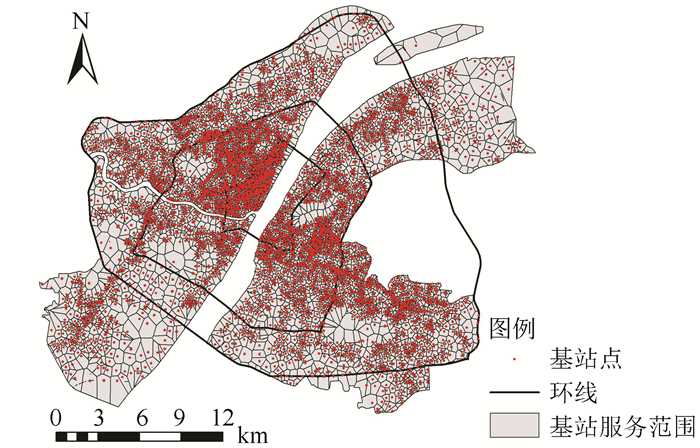
 下载:
下载:
